1 Open-air exhibition
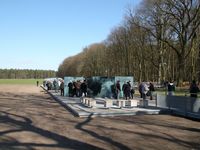
The open-air exhibition shows the history of the Death March, of Sachsenhausen concentration camp and of the camp in Below Forest in April 1945, with photographs and original documents, as well as quotations and drawings by survivors. It also deals with the clearance of other concentration camps, with the far too few perpetrators who were ever brought to justice and with the history of commemoration of the Death Marches. The exhibition’s transparent glass display panels are set up parallel to the historic forest site and communicate with the surroundings.
2 Display case with finds
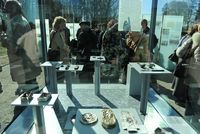
The centrepiece of the exhibition is an open-air display case containing objects found in Below Forest, including eating utensils owed by inmates, remains of tinned food from their International Red Cross food parcels and small boxes and graters made by the inmates themselves.
3 Walkway
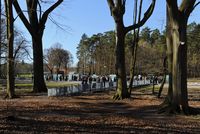
From the display case a walkway leads to the historic site of the forest camp, where the displayed objects were found. It leads visitors to the museum path that takes them through the historic forest site and shows them some of the most interesting traces remaining in the trees.
4 Forest site
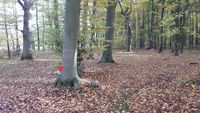
The historic forest site covers an area of around 500 m by 400 m. 16,000 to 18,000 inmates from Sachsenhausen concentration camp had to spend several days in April 1945 in this patch of forest in the open air without any food or water. There are many traces of this provisional camp still remaining today – inscriptions scratched into around one hundred of the trees, some of which are now very hard to make out. Nearly 4,000 objects have been found here as well.
5 Museum path
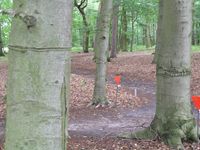
The museum path leads visitors to some of the most interesting trees, which bear various traces of the forest camp, and to a few reconstructions of temporary shelters. Seven thin glass panels along the path help visitors to read the traces, some of which are now very hard to make out. The path begins at the walkway and ends at the memorial monument. The walk through the forest site and the along the museum path lasts around 35 minutes.
6 Beech with scratched inscription
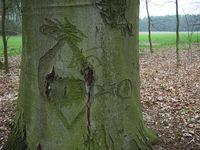
On many of the beech trees there are carvings and inscriptions scratched there by inmates; many are still in very good condition, but others are hardly recognisable now. This beech has a well-preserved carving that probably depicts a turnip, with a five-pointed star, which suggests that it might have been a Soviet inmate who scratched this inscription.
7 Pine tree with bark missing
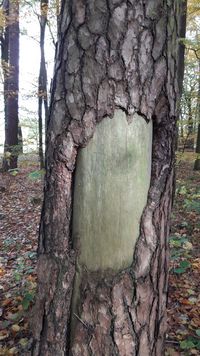
The most striking of the historic traces in Below Forest are probably the pine trees which even now still lack large areas of their bark. In their desperation in April 1945, the inmates peeled the bark off to eat it. With home-made graters, such as can be seen in the display case in the open-air exhibition, they grated the pieces of pine bark and stirred the sawdust produced in this way into water gathered from ditches and puddles to make a kind of porridge that they heated on an open fire and ate.
8 Reconstruction of a temporary shelter
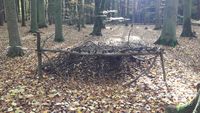
Those of the inmates in the forest camp who were still physically able to made temporary shelters from branches and leaves in which they spent the nights packed tightly together so as to get at least some protection against the cold and wet. The Memorial has reconstructed a few of these shelters in several projects with young people.
9 Beech with scratched inscription
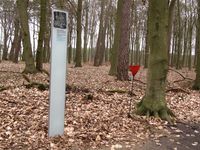
Most of the inscriptions and carvings scratched into the beeches depict names and numbers, but there are also symbols and pictorial representations of various objects. An entire landscape picture has been carved into this beech – a house with a jetty and a boat. Perhaps this was the home the artist yearned to return to? What is most noticeable about this carving is that it is the only one to have been executed low down on the trunk and was probably done in a lying position. The artist may have been ill or exhausted.
10 Memorial monument
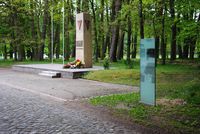
The memorial site was inaugurated in 1975. As well as the stele with the platform and flagpoles, it also includes the flag square on the other side of the road. During the GDR period this is where the flags were hoisted of the 18 countries the inmates came from. The people attending rallies here gathered on the so-called parade ground. The three-sided stele with three red ceramic triangles echoes the obelisk in the Sachsenhausen Memorial.
11 Educational project workshop
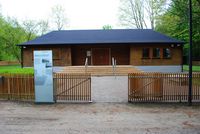
This building, built in 1981, is where the so-called Museum of the Death March was situated. In 2002, a fire attack by neo-Nazis destroyed one of the two display rooms. In the course of an extensive redesigning of the Memorial in 2010, the building was converted into a project workshop with event rooms and seminar rooms. Its flexible spatial arrangements and mobile furniture provide space for several small groups working on projects.

